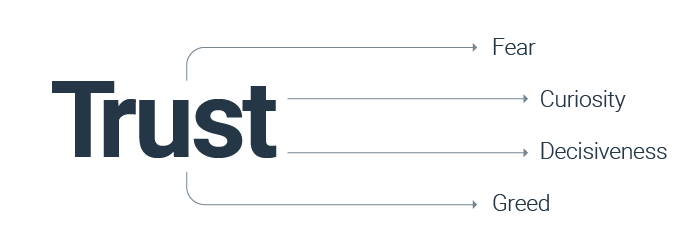 Human beings, businesses and civilizations thrive on a foundation of
trust – and hackers thrive on manipulating that trust. Social engineering is the phrase used to describe the many actions involved when an individual or group
engages in lying and using technology to manipulate trust relationships.
Human beings, businesses and civilizations thrive on a foundation of
trust – and hackers thrive on manipulating that trust. Social engineering is the phrase used to describe the many actions involved when an individual or group
engages in lying and using technology to manipulate trust relationships.
The goal of a social engineer is to carefully create a condition of “false trust,” where an individual reveals information or otherwise takes an action that leads to a security breach. While social engineering can involve the use of malware and ransomware, that is not the focus. The focus is exploiting the natural behavior of human beings. In many ways, that “false trust” condition is the result of what you could call a “reality distortion effect.” In fact, some social engineers will refer to the practice of manipulating a person as putting that person “in the zone.”
Social engineers try to put victims in a mindset that makes them highly suggestible and willing to take actions that they would otherwise find questionable.
Most human beings have very good defense mechanisms they rely on to avoid being deceived. The average person can quickly evaluate a situation and determine that something is amiss – similar to a “lie detector” filter. Yet, social engineers find ways to manipulate motives as a way of lowering our defense mechanisms and even our inhibitions.
Attackers who engage in social engineering attempt to manipulate very human motivations, including:

These are just a few of the motivations; a good social engineer can identify additional motivations by carefully profiling an individual, group or company. A social engineer is always more successful if they have large amounts of data about the intended victim.
Most social engineers find ways to wrap a lie inside of many truths. A well-prepared attacker can find it relatively easy to create the right kind of situation to make you feel comfortable or make you feel that the attacker is worthy of your trust. Once that one lie (a bad hyperlink in an email, or a simple request for information, for example) is carefully couched inside a plausible – but fraudulent – context, the attacker can get you to take action. It’s all about context and a social engineer’s ability to manipulate your natural human instincts.
When a human being is distracted, or otherwise not paying sufficient attention, it is possible for attackers to succeed. The goals of a social engineer are to get you to:
In a nutshell, the steps involved in a social engineering attack include those listed below in Table 1.
| Stage | Description |
|---|---|
| Business plan development | This is the attack plan. |
| Research | Successful attackers spend the most time on the research stage. |
| Pretext development | Next to research, this is the most vital, time-consuming stage. |
| Weaponization | This is the attack preparation stage. |
| Infiltration | The physical breach. |
| Delivery | The delivery stage. |
| Attack | The weaponized technology is activated. |
| Exploitation | The attacker activates the code used to compromise the system. |
| Monetization | The profit stage. |
Check out The Process of Social Engineering infographic
For the end user especially, the most critical stages of a social engineering attack are the following:
These two stages are where the attacker needs to be the most creative and ingenious. If they fail to gain critical information or fail to craft the correct pretext, the exploit will fail.
Secondarily, attackers need to use technology that is not easily detectible. But, in many cases, the social engineering research and pretext are so thorough that the attacker can use well-known, relatively “off the shelf” software exploits and malware. Attackers carefully weigh the cost-to-benefit ratio of their methods. In many cases, developing a sophisticated pretext is more cost effective than creating sophisticated software.
There are a few keys to successful pretexting:
After research and pretexting, the most sensitive stage for the attacker is successfully completing the attack. They need to use software that is effective but not easily discovered. After research, pretext creation and exploitation, another area of risk is monetizing the stolen information or access. But attackers, like pickpockets, have sophisticated networks that allow them to fence their ill-gotten goods.
Listed below are a few additional methods for manipulating human behavior:

So many attack methods exist. Here are the most common types of social engineering tactics:
So, now you know the problem. Table 2 lists a few tips for avoiding being a victim.
| Tip | Description |
|---|---|
| Train end users | People tend to behave differently at work than at home when it comes to responding to social engineering requests. Savvy organizations create programs that help their employees recognize sophisticated social engineering attacks. |
| Create a healthy sense of skepticism | Individuals should be ready to ask questions and avoid acting, even if the appeal – or pretext – is convincing. |
| Avoid haste | Take a deep breath, go for a quick walk or do something else and think about what you’re doing. Once you develop a habit of thoughtfully approaching your use of technology, you’ll be a much safer user of technology. |
| Verify the source | If you receive a request, verify that it really came from a legitimate source. It is important to trust but verify. |
| Avoid distraction | Develop ways to recognize when you’re distracted. |
| Use a spam filter | A good set of email spam filter rules can block even sophisticated social engineering attempts. |
| Become technologically literate | Learn enough internet technology to recognize when tech is being used against you. |
| Use out-of-band communication | If you receive a request via email, verify that request by texting or phoning the individual who made it. Don’t use the initial form of communication to respond. Using a separate form of communication is often called communicating out-of-band. |
| Remember who made first contact | Social engineers do their best to make you forget that you were just minding your own business before the attacker started manipulating you. |
| Avoid clicking on links and attachments | Yes, most computers are protected by automated security tools (e.g., antivirus). But think before you click. |
| Have a response plan | Be ready to contact IT support or take appropriate action if you feel you have fallen victim. Write down your plan. |
| Read carefully | Your internal lie detector will work better if you take the time to examine requests. |
Check out How to Avoid Social Engineering Attacks infographic
Social engineers are just one type of cybercriminal, and they put in the work to stay ahead of cybersecurity professionals. As these types of attacks become more sophisticated, it’s up to IT pros to build a line of defense that includes going on the offense. The more you know about how attackers work, the better chance you have of catching them in the act and preventing a major loss.
Read more about Cybersecurity.
Tags : Cybersecurity